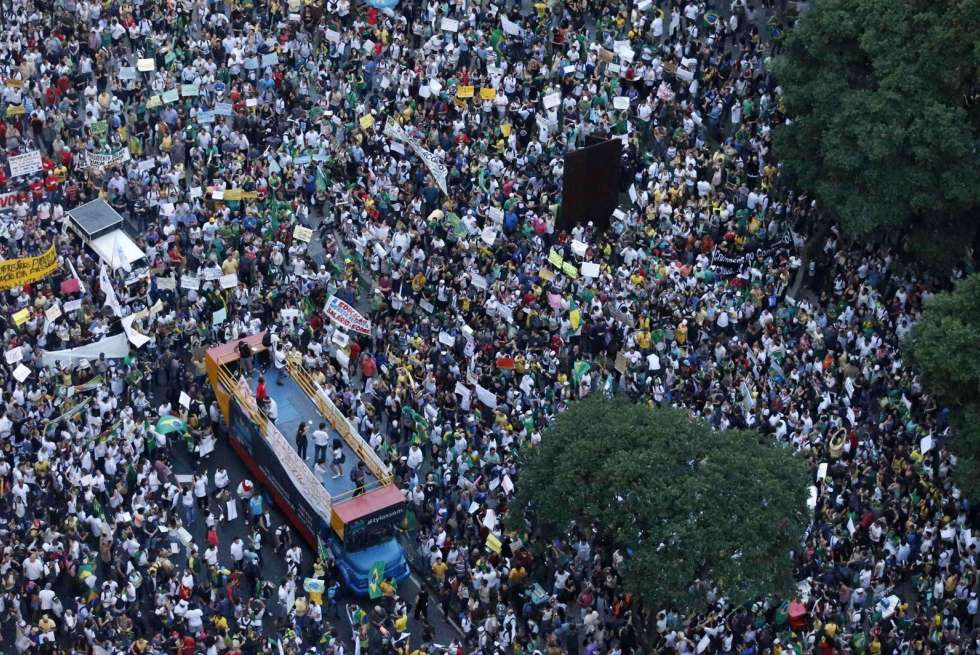Protests in Rio de Janeiro: Socio-Technical Overlap between “Networks” and the Streets
From the Series: Protesting Democracy in Brazil
From the Series: Protesting Democracy in Brazil

I attended four demonstrations in Rio de Janeiro that took place on June 10, 14, 17, and 20. I will be concentrating on two points: first, that these demonstrations were initially mobilized by the social networks established on the Internet, especially Facebook but also Twitter, Whatsapp, and YouTube; and second, on the presence at these protests of a majority of young people without ties to official organizations, associations, or parties.
During the eleven-day period of these protests, the voice of the multitude began to make a series of demands for participation that were being repressed by different scales of governments. At the first demonstration, with less than one-thousand people, the main target was a BRL$0.20 increase in bus fares. Beginning with the second, attended by approximately ten-thousand people, other agendas were incorporated. The third protest, with over one-hundred-thousand people, saw an explosion of demands. During the fourth, one-million people went to the streets in Rio de Janeiro to celebrate the fare reductions achieved the day before, but also to send the message that all this protesting was about more than just the 20 cents.
How should we understand the role of new information and communication technology, especially the Internet, in these protests? With this question in mind, my goal is to draw attention to a type of collective action performed on the Internet, itself defined as numerous forms of technology, practices, and contexts used, understood, and assimilated by many people in some specific place (Miller and Slater 2000). There are increasingly evident socio-technical overlaps (Latour 2005), considering the ubiquity with which Internet technology participates in the quotidian life of contemporary societies, even if the digital divide continues to exist (Bimber et al. 2012). It does not seem possible to analyze what happens in Brazil without consider technologies, particularly the Internet.
As I participated in the protests in Rio de Janeiro, I observed a dynamic that Manuel Castells (2012) has identified in protests like the Arab Spring, Occupy Wall Street, and the Movement of the Indignant: all of these demonstrations started with indignation on Internet networks, moved onto the streets, then back to the Internet and onto the streets again. The movements stayed alive on networks through the Internet, with the ability to unfold into small daily small protests, until more people and themes coalesced, such as what appears to be in progress Brazil, particularly in Rio de Janeiro.
This dynamic of feedback between Internet networks and street presence poses several challenges for any analysis of collective action. Internet technologies are important for their contribution to the multi-centered character of a movement without formal leaders, which, however, is not a new development of these movements. At least since the anti-globalization protests—Seattle in 1999 and perhaps even since the Zapatista uprising in 1994—these characteristics have been present, though in sometimes quite different ways.
One difference lies in the changes to the Internet. In 1994 and 1999, communication via networks was achieved through discussion lists and email exchanges, while today this communication takes place through social-network sites, in addition to cell phones, which are increasingly connected to the Internet. This change has led to the ability to mobilize faster, and it is directed more at demonstrators' personal networks of contacts.
It is worth considering the possibility that this type of collective action of the multitude should be linked back to the common catalyzation of a networked individualism, where each participant mobilizes his or her own networks, more than to organizations that mobilize their members. This calls attention to the lack of participants’ ties to organizational structures. Even those who do have ties appear to be mobilizing their personal contact networks using Internet technology. Citizens that create and mobilize personal networks to engage people in demonstrations seems to be more important than membership organizations.

Forms of organization, mobilization, and demonstration are undergoing changes and innovations, establishing repertoires of collective action (Tilly 1995). It appears that the Internet brings new possibilities, expanding the repertoire of collective action. Some authors have spoken of the emergence of a digital collective-action repertoire, which appears to have established itself with the advent of the Internet (Earl and Kimport 2011), and is mixed with the modern repertoire, pointing to socio-technical overlaps in collective action. Without Internet technologies, the demonstrations in Brazil would be, at least, of a different scale.
Socio-technical overlapping is not only seen among those who demonstrate. During the demonstrations, police officers were seen filming with their own cell phones as well as attempting to confiscate demonstrators’ cell phones. By apprehending cell phones, the police apparatus is attempting to separate the "social” from the “technical,” undoing the possibility of sharing, oftentimes instantaneously, images and impressions with networks of demonstrator contacts. This shows that a cell phone connected to the Internet is a weapon for demonstrators making it possible to propagate commotion and the hope for new engagements in collective action, often times fed by police violence that has been employed against demonstrators on the streets.
Bimber, Bruce, Andrew Flanagin, and Cynthia Stohl. 2012. Collective Action in Organizations: Interaction and Engagement in an Era of Technological Change. New York: Cambridge University Press.
Castells, Manuel. 2012. Networks of Outrage and Hope: Social Movements in the Internet Age. Cambridge: Polity Press.
Earl, Jennifer, and Katrina Kimport. 2011. Digitally Enabled Social Change: Activism in the Internet Age. Cambridge, Mass.: MIT Press.
Latour, Bruno. 2005. Reassembling the Social: An Introduction to Actor-Network-Theory. Oxford: Oxford University Press.
Miller, Daniel, and Don Slater. 2000. The Internet: An Ethnographic Approach. New York: Oxford International Publishers.
Tilly, Charles. 1995. “Contentious Repertoires in Great Britain, 1758–1834.” In Repertoires and Cycles of Collective Action, edited by Mark Traugott. Durham, N.C.: Duke University Press.